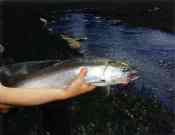| In this issue:
ALL NEW ONTARIO BOATS FOR
SALE CLASSIFIEDS
CLICK HERE!
TOTAL TACKLEBOX
We are on our way to becoming the worlds largest fishing
tackle search engine!
|
Red
Pine Wilderness Lodge
- Our 8 guest cottages set amidst
towering, red
pine trees on a 7 acre
island is the place for your special remote fishing trip or
wilderness family holiday. We are the Gateway to two huge parks:
The Obabika Waterway Park and The Lady Evelyn/Smoothwater
Wilderness Park. We offer the serious angler Northeastern
Ontario's finest Walleye (Pickerel), Great Northern Pike,
Smallmouth Bass, Whitefish and Perch fishing. Don't forget about
the 3 species of Trout that also call this area "home".
Lakair Lodge
- With miles of twisting shoreline, picturesque islands and
hidden back bays. Choose from 1, 2, 3 or 4 bedroom cabins, each
with a modern generously outfitted kitchen and 3 piece bath.
After a hard day fishing, put your feet up and relax on your own
sundeck or screened in porch. American Plan guests will enjoy
three delicious meals daily plus maid service (including towels
and bedding).
Sunbeam Bungalows - A family and
fishing resort. Located in the small, picturesque hamlet of
Callander, Ontario, yet only 10 miles from larger city
attractions. Our resort is nestled under the pines, where we
offer clean, fully-furnished, deluxe, spacious cottages. Enjoy
Lake Nipissing which offers the best in fishing...we guarantee
to believe all stories about "the one that got away".
|
|
"Discover the Joy of Small-Stream Trout" By
Justin Hoffman
 Imagine
yourself exploring a small tranquil stream - lost in your own world
yet in the thick of trout country. Cascading waterfalls, riverbank
critters and satisfying solitude are yours to enjoy and explore for
the length of a day. Thousands of tiny creeks and rivers call
Ontario home, and the wondrous colours and energetic tussles that
the resident brookies, browns and rainbows exhibit is like
discovering a new realm in the land of angling fun. Come take a walk
off the beaten path and reap the rewards that small-stream fishing
can offer. Imagine
yourself exploring a small tranquil stream - lost in your own world
yet in the thick of trout country. Cascading waterfalls, riverbank
critters and satisfying solitude are yours to enjoy and explore for
the length of a day. Thousands of tiny creeks and rivers call
Ontario home, and the wondrous colours and energetic tussles that
the resident brookies, browns and rainbows exhibit is like
discovering a new realm in the land of angling fun. Come take a walk
off the beaten path and reap the rewards that small-stream fishing
can offer.Finding A Stream
Finding a small stream that is rich with resident trout can be
as simple as doing a little bit of homework before heading out.
Chances are you drive by or over a small stream or creek every day
on your way to work or out shopping. These can be teeming with
hungry fish, yet are never given a second look from unsuspecting
anglers passing constantly through. Stop your vehicle the next time
you hurriedly pass by and discover what treasure may possibly await
you under that man-made bridge.
Another trick is to call your local Fisheries or Environment offices
in order to find out stocking records for the area you are
interested in exploring. They may even go as far as letting you know
quantities of fish that have been stocked, which can be a real bonus
in finding the perfect honey hole. Road maps and topographical maps
can help you find a gem in the rough by showing small streams and
creeks and the roads to access them. Circle a half dozen of these
urban prospects and take a leisurely drive through town to find the
one that suits you, and the small-stream trout, best.
Tackling Trout
There are two routes to take when targeting small-stream brook
trout - spinning or flyfishing gear. Each has its own merits, and it
is really a matter of personal choice when it comes to picking a
method. Whichever one you choose, the key aspect is to keep it
light. Rods should be short and line should be a thin diametre.
Remember, the trout you will be targeting will not be monstrous, and
neither should your equipment. Most of these urban dwellers will be
measured in inches, not pounds, so light action tackle is definitely
the way to go.
For spinning gear, my personal choice is an ultra light rod between
four and five- feet in length. A rod of this size will make it
easier to travel through bushy undergrowth and to deal with small
stream conditions. Line in the two to four-pound-test weight is all
that is required. Most streams you will come across will be crystal
clear, and many of the fish are extremely "line shy."
There is a large array of small-stream baits on the market, but I
find it best to keep everything simple. Small number 0 spinners are
extremely effective, especially in silver or gold tones. If the
water happens to be a bit murky, a switch to a fluorescent hue may
do the trick. Tiny crankbaits have also fooled many a trout for me
over the years, and are most effective when "hotshotted."
Hotshotting is a simple and effective technique for small-stream
trout - here's how it works. Stand upstream of fast water and let
your crankbait float down current until it is at the point where the
rapids spill into the pool. Engage your reel and the bait will dive
and wobble in place. Slowly let the bait slip back through the
rapids and into the deeper water. Baits can be sent under fallen
trees or log jams in order to access hidden fish. This is a great
technique for tempting those fish that lazily and stealthily hide in
the dark shadows of cover waiting for an easy meal to swim by. |